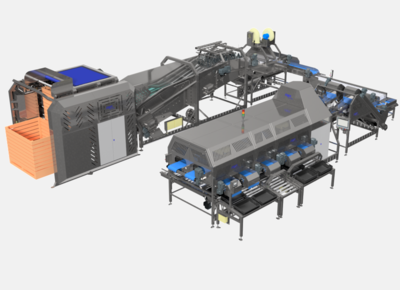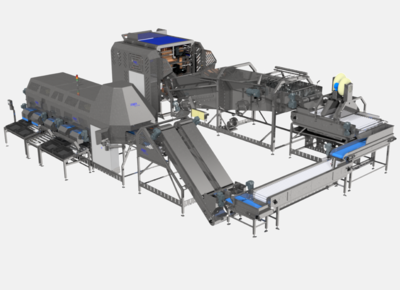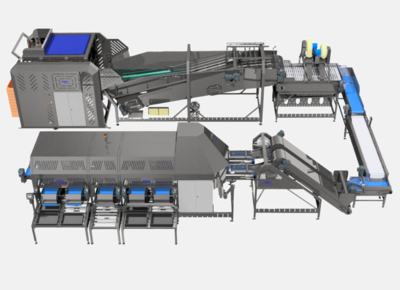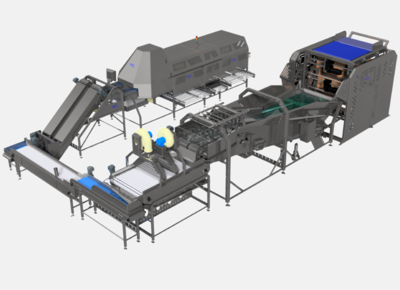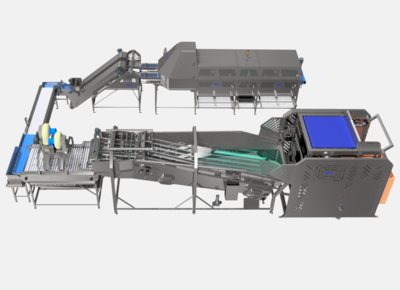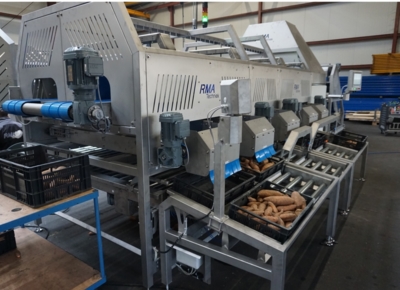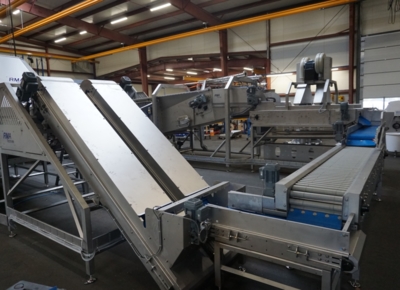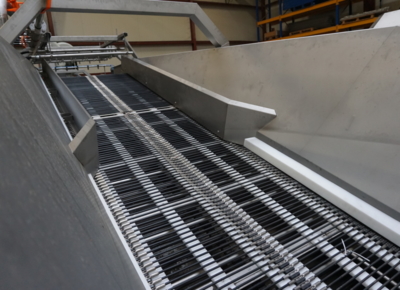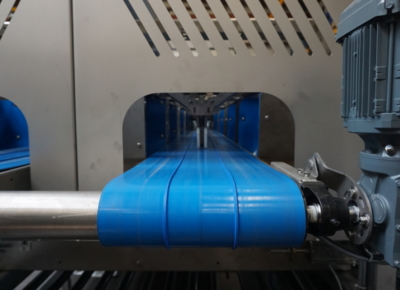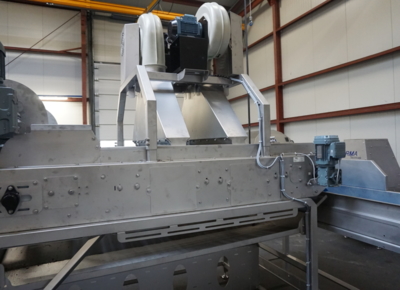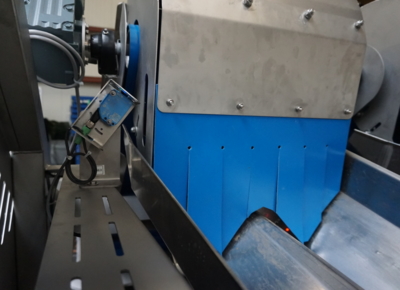Sweet Potato Processing Line
A processing line for sweet potatoes developed by RMA Techniek to inspect potatoes on quality.
Tilter
A potato box of 1600*1200*1230 mm is placed in the Tilter with a forklift. When the forklift is out of the Tilter and start is pressed, the box is clamped against a tire. When the box is clamped, the Tilter will turn until the box is in the correct position. The box then slides slowly over the belt, so that the contents are dosed into the buffer bin. When the box is empty, it retracts again and turns the box back to the starting position. Here the empty chest can be taken from the Tilter again.
Buffer bin
The potatoes are unloaded in the Buffer bin by the Tilter. At this stage, they fall into a container of water. At the bottom of the tray a conveyor belt is placed that transports the potatoes to the rinsing section. Furthermore, a screw turns in the Buffer Bin that transports all the sludge and tare to the drain. Doing so, will prevent the bottom of the container to be filled too rapidly. At the end of the conveyor belt, the sweet potatoes are rinsed by means of six spray tubes with nozzles. Meanwhile, the potatoes will roll on the next conveyor belt, so they are well sprayed on all sides. At the end of the second belt another spray tube is placed with the nozzles slightly closer together to spray the remaining tare residue off the potatoes. Subsequently, the sweet potatoes are unloaded onto the Drying Belt.
Drying belt
The Drying belt is equipped with a roller belt which allows the sweet potatoes to be rotated slightly during the drying process. The potatoes are transported by means of the roller conveyor through low-pressure air knives. As a result, it will blow off most of the moisture from the potatoes. Next, the Drying Belt unloads the sweet potatoes onto a cross belt, which unloads the potatoes onto the Roller inspection table.
Roller inspection table
The sweet potatoes are dosed via the cross conveyor and unloaded onto the Roller inspection table. The Roller inspection table is equipped with a roller conveyor after which the sweet potatoes rotate slightly so they can be inspecteda. There is space on both sides of the Roller inspection table to inspect the sweet potatoes. Any crate for defects/tare must be provided yourself. Ultimately, the Roller inspection table unloads the sweet potatoes into the dosing system via a cross conveyor.
Dosing system
The sweet potatoes are unloaded via a cross conveyor from the Roller inspection table into the hoppers of the Dosing system. The Dosing system consists of two tracks for the sweet potatoes. The funnels are already equipped with a separator plate at the top, which divides the number of potatoes in two. The sweet potatoes are transported upwards from the hopper by means of an elevator belt. The elevator conveyor unloads the potatoes on a vibrating chute where the number of potatoes is singled out by means of vibrations. The vibrating chutes unload the sweet potatoes onto the Sorter's infeed belt.
Sorter
The sweet potatoes are unloaded on the infeed belt of the Sorter. The infeed conveyor of the Sorter is equipped with a 3D camera and many flippers to sort the potatoes. The potatoes are transported under the 3D camera by means of the conveyor belt. The 3D camera can measure the length, width, and height of the potatoes without stopping the conveyor belt. After the 3D camera, the potatoes are given a push at the right location so that they end up on 1 of the 5 underlying belts from the supply belt. Potatoes are unloaded from these belts into crates that are placed on an underlying roller conveyor. After this, the full crates can be manually removed from the track.
Conveyor Belts
The conveyor belts are used throughout the installation to guide the potatoes through the process. Various types of conveyor belts are used within the installation.
The complete sweet potato processing line consists of the following machines:
- Conveyor belts
- Tipper
- Buffer tank
- Drying belt
- Roller inspection table
- Dosing System
- Sorter
If you would like to know more about the possibilities? Feel free to contact us.


